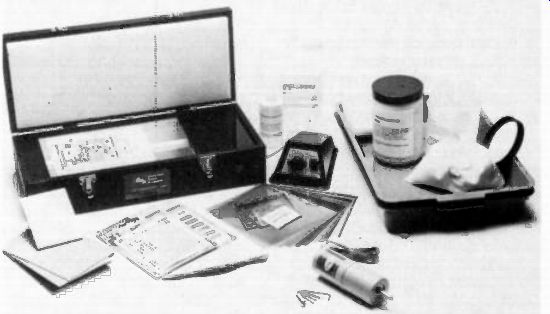This month we are going to discuss two quite unrelated products, both of which are, however, very useful.
Micro Design recently sent us a port able microfiche reader. With more and more service data available on micro fiche-often less costly than standard printed copy, and an obvious choice for outside service-the Micro Forty-Four is very logical for field service or when a compact unit is needed on the bench.
The Micro Forty-Fours screen is about 4 inches square, which seems a small area on which to project a standard 8 1/2 x 11 inch page. I had no trouble reading any of the text or schematics viewed, however. Focus and brightness are good.
The Micro Forty-Four measures about 3 x 5 x 12 inches, and is obviously very portable; it has as accessories a soft carrying case, an ac adapter, a cigarette lighter adapter, And a battery holder. A hard carrying, case also is available. Lenses are available for various magnifications.
We also received, some time ago, a circuit board prototype kit from Electronic Trend Products. This kit, ETP-II, contains all the equipment and supplies necessary to produce circuit boards and panel labels of up to 6 x 9 inches. Major components of the kit are an ultraviolet exposure unit, a high speed drill, trays, developer, etc., and a timer. A variety of glass laminate board and label material also is included.
I have worked with various circuit board processes off and on for a long time, but certainly am not expert in any way.
The kit processes required a little learning; our first try didn't look very good.
With a little practice, very acceptable boards resulted. To produce a board, the pattern is laid out with drafting aids on transparent drafting film using a 0.1 inch grid behind it for accuracy. The pattern is placed on the resist coated board and exposed, developed and etched-a straightforward process.
We used--copied--a circuit board layout from Weekend Projects For the Radio Amateur. The circuit selected was a power supply regulator board measuring about 2 x 4 inches. Our first at tempt did not etch properly; streaks of copper were left on the board. We looked things over and carefully tried again. This time we produced an acceptable board.
A little experience and experimentation is very useful.
Schematics and circuit boards

--------- Electronic Trend Products ETP-11 prototype kit.

--------- A microfiche reader and a prototype kit. Micro Design's Micro
Forty-Four.
(source: Electronic Technician/Dealer)
Also see: